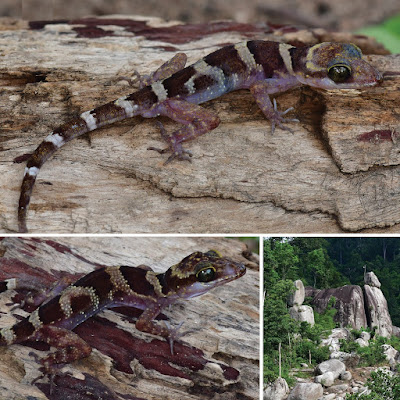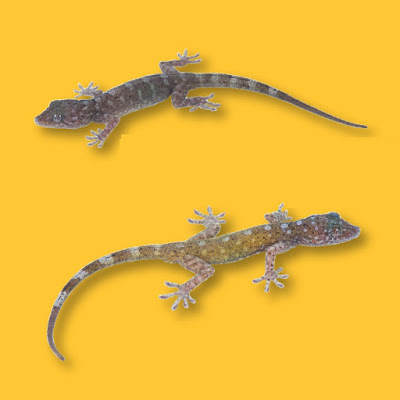[Most Recent Entries] [Calendar View]
Tuesday, April 14th, 2020
| Time | Event | ||||||
| 2:55a | [Herpetology • 2020] A Morphological and Molecular Revision of Lizards of the Genus Marisora Hedges & Conn (Squamata: Mabuyidae) from Central America and Mexico, with Descriptions of Four New Species
Abstract The skink genus Marisora ranges from Mexico to northern South America and occurs on some islands in the Caribbean Sea. We conducted a revision of the genus Marisora from Mexico and Central America, using new morphological and molecular data, and find support for the five previously described species (Marisora alliacea, M.aurulae, M. brachypoda, M. magnacornae, and M. roatanae) and describe four new species: Marisora lineola sp. nov., M. aquilonaria sp. nov., M. syntoma sp. nov., and M. urtica sp. nov. We show that two species previously known only from Central American islands, M. magnacornae and M. roatanae, also occur on the adjacent mainland and that two species recently placed in Alinea belong to this evolutionary clade: Marisora berengerae n. comb. and Marisora pergravis n. comb. Together with M. falconensis and M. unimarginata, these 13 species of Marisora arose mostly in the Pliocene and are largely allopatric but are sympatric and nearly sympatric at several locations in Central America where they maintain their morphological and genetic distinctiveness. Keywords: Reptilia, reptile, skink, evolution, systematics, taxonomy, classification, ecology, conservation, reproduction, biogeography, Middle America James R. McCranie, Amy J. Matthews and S. Blair Hedges. 2020. A Morphological and Molecular Revision of Lizards of the Genus Marisora Hedges & Conn (Squamata: Mabuyidae) from Central America and Mexico, with Descriptions of Four New Species. Zootaxa. 4763(3); 301–353. DOI: 10.11646/zootaxa.4763.3.1 | ||||||
| 3:42a | [Herpetology • 2020] Cyrtodactylus phnomchiensis • A New Species of Cyrtodactylus (Squamata, Gekkonidae) from Cambodia’s Prey Lang Wildlife Sanctuary
Abstract Cyrtodactylus phnomchiensis sp. nov. is described from Phnom Chi, an isolated mountain in Prey Lang Wildlife Sanctuary, Kampong Thom Province, Cambodia. The new species is recognized by having a unique combination of morphological characters, including snout-vent length 76.1–80.7 mm; paravertebral tubercles 31–36; ventral scales 45–54; enlarged femoral scales 0–8, without pores; enlarged precloacal scales 7–10, bearing pores 4–5 in males, pits 1–7 in females; the posterior border of nuchal loop unbroken and pointed, bordered anteriorly and posteriorly by a broad yellow or yellowish white band; and yellow spots on top of head. The new species also represents a divergent mitochondrial DNA lineage within the C. irregularis complex that is closely related to C. ziegleri, but the phylogenetic relationships among the new species and two divergent mitochondrial subclades within C. ziegleri are not resolved based on available sequence data. Cyrtodactylus phnomchiensis sp. nov. is the only member of the C. irregularis complex known to occur west of the Mekong River. The new species may be endemic to Phnom Chi, and likely faces imminent conservation threats. Keywords: Cyrtodactylus irregularis, C. ziegleri, Mekong River, Phnom Chi, Sphenomorphus preylangensis
Cyrtodactylus phnomchiensis sp. nov. Etymology: The specific epithet is taken from the type locality of Phnom Chi and the Latin suffix -ensis meaning “originating from.” The specific epithet is masculine in agreement with the gender of Cyrtodactylus. Diagnosis: Cyrtodactylus phnomchiensis sp. nov. is distinguished from the 19 other named species in the C. irregularis group (Ngo and Chan 2010; Nguyen et al. 2013, 2017; Pauwels et al. 2018) by having the combination of SVL 76.1–80.7 mm; relatively long body, AG/SVL 0.451–0.481; relatively long tibia, CrusL/SVL 0.172–0.200; subdigital lamellae on fourth finger 18–20; subdigital lamellae on fourth toe 20–23; longitudinal dorsal rows of tubercles 18–20; paravertebral rows of tubercles 31–36; ventral scales 45–54; enlarged femoral scales 0–8, without pores; enlarged precloacal scales 7–10, bearing pores 4 or 5 in males, pits 1–7 in females; precloacal groove absent; median row of transverse subcaudal scales only slightly enlarged; posterior border of nuchal loop unbroken and pointed, bordered anteriorly and posteriorly by broad yellow or yellowish white band; dark brown body bands 3 or 4, the first intact, the second, third and fourth more irregular, alternating with two or three yellowish white or light brown body bands, about half the width of dark brown body bands; and yellow spots on top of head.
Distribution and natural history: The new species is known only from the type locality at Phnom Chi in Prey Lang Wildlife Sanctuary, Kampong Thom Province, Sandan District, Cambodia. All individuals were found at night between 2001–2147 hr in evergreen-large dipterocarp dominated forest associated with rocky terrain (Fig. 7). The holotype CBC 03012 was found on a rock face following evening rain, paratypes CBC 03013–14 were on boulders following evening rain, paratype CBC 03003 was on leaf litter along a forest trail, and paratype CBC 03004 was on a rock wall at the entrance to a cave. Only five individuals were found during five-survey nights, suggesting the species is relatively uncommon. None were encountered during a brief survey by NT in the wet season of 2014 (Hayes et al. 2015). The new species is the only member of the C. irregularis complex known to occur west of the Mekong River (Nguyen et al. 2017; Pauwels et al. 2018). Thy Neang, Adam Henson and Bryan L. Stuart. 2020. A New Species of Cyrtodactylus (Squamata, Gekkonidae) from Cambodia’s Prey Lang Wildlife Sanctuary. ZooKeys. 926: 133-158. DOI: 10.3897/zookeys.926.48671 | ||||||
| 4:04a | [Herpetology • 2019] Gekko flavimaritus • A New Karst-dwelling Gecko of the Gekko petricolus group (Reptilia: Gekkonidae) from Phitsanulok Province, central Thailand
ABSTRACT We describe a new species of the genus Gekko from Phitsanulok Province, central Thailand. Gekko flavimaritus sp. nov. can be distinguished from its congeners by a combination of morphological characters: medium size for Gekko (snout–vent length 76.0–84.5 mm in six adult males, 67.5–78.3 mm in 11 adult females); nares in contact with rostral; two enlarged postmentals; 12–16 dorsal tubercle rows; 27–35 ventral scale rows; 10–15 subdigital lamellae on first toe, 15–18 on fourth toe; finger and toe webbing weakly developed; tubercle absent on dorsal surface of forelimbs and hindlimbs; adult male with 7–8 precloacal pores, in continuous row; precloacal pores absent in females; single postcloacal tubercle on each side; tubercles present on dorsal surface of tail base; subcaudals enlarged; sexual dimorphism present (colouration on dorsum in life — yellow in adult males and brownish grey in adult females); dorsum with whitish vertebral blotches between nape and base of tail. Genetically, the new species is nested within the G. petricolus group and is closely related to G. boehmei and G. petricolus. The new species has uncorrected pairwise divergences of ≥ 18.57% of the ND2 gene from other species of G. petricolus group. Additionally, we present the first genetic data for G. lauhachindai, and verify its morphological assignment to the G. petricolus group. Keywords: Gekko flavimaritus, Gekko lauhachindai, taxonomy, molecular phylogeny, karst formation
Gekko flavimaritus Rujirawan, Fong and Aowphol, sp. nov. Etymology: The specific epithet flavimaritus is taken from flavus L. for yellow and maritus L. for married man or husband, in reference to the adult males of the new species having yellow colouration on the dorsum in life. ตุ๊กแกเนินมะปราง Attapol Rujirawan, Jonathan J. Fong, Natee Ampai, Siriporn Yodthong, Korkhwan Termprayoon and Anchalee Aowphol. 2019. A New Karst-dwelling Gecko of the Gekko petricolus group (Reptilia: Gekkonidae) from Phitsanulok Province, central Thailand. Journal of Natural History. 53(9-10); 557-576. DOI: 10.1080/00222933.2019.1597937 ตุ๊กแกสายพันธุ์ใหม่ (Gekko flavimaritus) |
| << Previous Day |
2020/04/14 [Calendar] |
Next Day >> |









